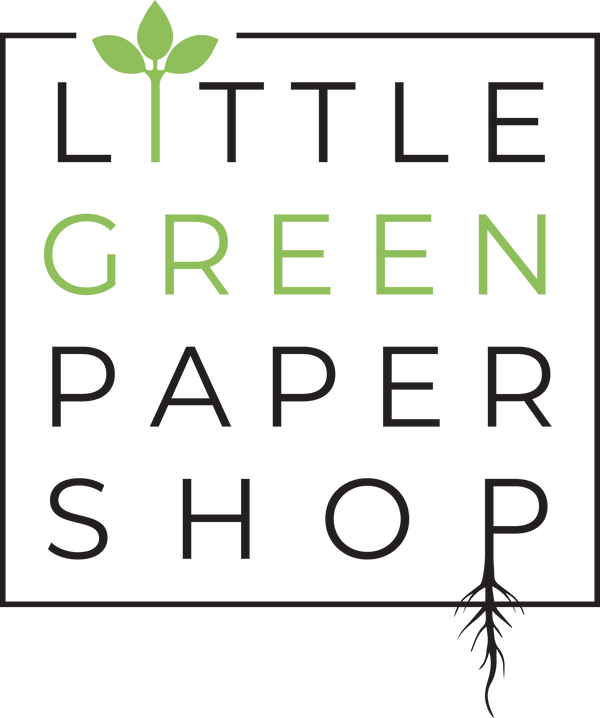If you’ve ever received a seed paper card or invitation, you’ve probably wondered: Does this really grow? It’s a great question, and the answer is a resounding yes—seed paper can grow! But how exactly does it work, and what should you know to ensure your seed paper turns into something beautiful?
At Little Green Paper Shop, we’re passionate about using sustainable materials like seed paper, which is made from textile waste and embedded with a variety of seeds. Here’s everything you need to know about how seed paper works and how to get the best results when planting it.
What is Seed Paper?
Seed paper is a type of paper that has been infused with seeds, allowing you to plant it and watch it grow. The paper itself is typically made from recycled materials, like textile waste or cotton scraps, which makes it an eco-friendly alternative to traditional paper products.
Seed paper can come in many forms—greeting cards, invitations, business cards, and even gift tags—all of which contain small seeds embedded within the paper fibers. The paper is biodegradable, meaning it will naturally break down in the soil, leaving only the seeds to sprout and grow.
How Does Seed Paper Grow?
Seed paper contains various types of seeds, such as wildflowers, herbs, or vegetables. Once planted, the paper breaks down in the soil, and the seeds begin to germinate. It’s important to note that while the paper itself decomposes quickly, the seeds require care to grow just like any other plant.
Here’s a step-by-step guide on how to plant your seed paper and get the best results:
-
Choose a Planting Location: Select a sunny spot in your garden or a container with good drainage. Most seed paper types, especially wildflowers, thrive in full sunlight.
-
Prepare the Soil: Loosen the soil and make sure it’s not too compact. For better results, use loose, well-draining soil. If planting in a pot, use a good-quality potting mix.
-
Plant the Paper: Lay the seed paper flat on top of the soil. You can also lightly cover it with a thin layer of soil (about 1/4 inch deep), but be careful not to bury it too deeply.
-
Water Regularly: Keep the soil moist, but not soggy. Water the area gently to ensure the seeds don’t get washed away.
-
Wait for Growth: Depending on the type of seeds, you’ll start seeing sprouts in about 1-3 weeks. Wildflowers typically take a bit longer to emerge, while herbs and vegetables can sprout quicker.
-
Enjoy the Bloom: As the seeds begin to grow, you’ll soon have a beautiful display of flowers, herbs, or vegetables, all from a simple card or invitation you once held in your hands.
Which Seeds Are in Seed Paper?
At Little Green Paper Shop, we offer seed paper that’s embedded with a variety of seeds. Common options include:
- Wildflowers: These are a popular choice, especially for events like weddings or parties. Wildflowers attract bees and butterflies, which helps support local pollinators.
- Herbs: Great for those who love to grow their own kitchen garden. Herbs like basil, thyme, and mint are commonly used in seed paper.
- Vegetables: Some seed papers contain vegetable seeds, such as carrots or lettuce, perfect for gardeners who want to grow their own food.
Be sure to check what kind of seeds are included in your seed paper product so you can take care of it accordingly.
How Long Does it Take to Grow?
The time it takes for your seed paper to grow depends on several factors: the type of seeds, the growing conditions, and the season. Typically, you’ll start seeing small shoots or sprouts in 1-3 weeks. However, wildflowers can take a bit longer to mature—sometimes several months—so patience is key.
What Happens After Planting?
Once your seed paper has been planted and the seeds have started to grow, you can enjoy the flowers, herbs, or vegetables that bloom from it. If you’re growing wildflowers, they’ll attract bees and butterflies, benefiting the local ecosystem. If you planted herbs or vegetables, you can harvest them for your own use.
Seed paper plants are also a reminder of the sustainable, eco-conscious choices you’ve made. By opting for a product that can grow into something beautiful, you’re contributing to a greener planet and helping reduce waste.
Tips for Successful Seed Paper Growth
- Water gently: Be mindful of how much water you give the paper. Too much water can drown the seeds, while too little may not allow them to germinate.
- Location matters: Choose a sunny spot. Most seed paper types need sunlight to germinate and grow.
- Don’t overplant: If you’re using a large sheet of seed paper, cut it into smaller pieces to plant in different locations, giving the seeds more space to grow.
Why Choose Seed Paper?
Choosing seed paper products, like cards or invitations, is a simple yet impactful way to reduce waste and promote sustainability. Rather than sending a traditional paper card that may end up in the trash, you’re gifting a card that can grow into something lasting—whether it’s a vibrant patch of wildflowers, a fragrant herb garden, or homegrown vegetables.
It’s a meaningful, eco-friendly gesture that leaves a lasting impression and contributes to a healthier planet. Plus, it’s a unique gift or keepsake that’s sure to be remembered!
Conclusion
So, does seed paper really grow? Absolutely! With a little care, you can plant your seed paper and watch it turn into something beautiful. Whether you're sending a plantable card to a loved one or using seed paper for a special event, you’re contributing to a greener future. At Little Green Paper Shop, we’re proud to offer eco-friendly, plantable products that not only make memorable gifts but also help reduce waste and support sustainable practices.
Ready to give it a try? Explore our range of seed paper products and start planting your love today!

